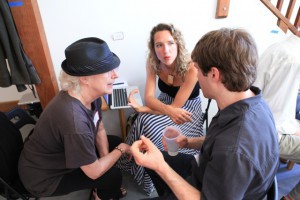By Jess Van Nostrand and Susie Lee
Posted on November 8th
“The work I did is the work I know, and the work I do is the work I don’t know.” - Philip Glass, 2012
Throughout the summer of 2012, The Project Room focused on “Solutions.” For this series, TPR Founder Jess Van Nostrand and artist Susie J Lee collaborated on a three-part experiment that brought together artists and technologists for some meeting, talking and making. The three parts were titled as follows: Speed Dating (Event #1), Dinner & A Movie (Event #2), and Gettin’ It On (Event #3).
Here they field questions from Off Paper Editor Jenifer Ward, who also participated in the experiment.
Jenifer: How did the two of you get started with this project?
Jess: I take my collaboration relationships very seriously. There is a mental strain in working within and around another person’s brain, and I save that experience for very special circumstances in which I know I will greatly enjoy nearly every minute of time spent with that person and their brain. Susie was that person for me.
Susie and I found that we both wanted to find a productive and inspiring way to bring artists and technologists together. We spent countless hours forging a formal structure that was not just another social mixer. We carved a structure that was considered, balanced, and activated through the time spent. It would be based on the development of a romantic relationship, from a blind date through, well, you know.
My job as the Founder/Director/bathroom cleaner of The Project Room is to identify themes that possess relevance for an audience, and to guide the programming as it responds to that theme. Susie also has a big-picture way of thinking, but as an artist, which means she is a maker of things. We complement each other well in what we know, what we are curious about, and who we are able to force to participate in an experiment like this. We spent time fretting about hypotheticals and distracting details like the starting time of an event, but we checked our fretting by remembering the experimental nature of the entire undertaking; as long as people were engaged, all would be fine.
Jenifer: Why now?
Susie: As a new media artist, I have a complicated and deeply ambivalent relationship with new media. My cell phone is from 2001. I don’t facebook. I couldn’t code to save my life (but I think I was tainted by my first C++ programming instructor who came in wearing a lab coat. I was like, “Uh….seriously? Those aren’t REAL viruses, you know….”) And yet I find an addictive cycle of returning to new media by asking the question: What are the ways that technology can touch humanity and bring us closer together? My collaborative practice makes things inherently messy, unpredictable and human. I have had fantastic collaborations with technologists because when we work together the conversations aren’t cyborg mind-melds but more like, “What the hell are you talking about??” Yet, it’s not a start of an argument, but a fascination that the one person is accessing a totally different language, visualization, order of operations and value system from other. Technologists and artists look at the same problem space through completely different filters.
There is a high percentage of technologists in this region. A few of those are interested in cultural endeavors and are curious about what others think in the same problem space. There are also artists (and I’d venture to say the percentage is higher) that are mystified and slightly suspicious of technologists’ thoughts and operations. Jess and I wanted to tap into that energy and curiosity to merge intelligent and motivated artists and technologists together in a room.
Jenifer: Did any of the results of the experiment surprise you?
Jess: Speed Dating was like a big hot noisy party, and then Dinner & A Movie was more work for everyone, I think. It was interesting—and surprising— how uncomfortable we all seemed to be with having an inconclusive event that was open to the public. I think there were a few times when someone said, “What are our deliverables here? What do you want us to do?” If we were at a real dinner party, no one would have asked that, but in a public event, we are trained to conclude something, or present something tangible. I was wondering if anyone would come back for the third event after that one! But, then, the third and final event brought the ideas together into a presentation format that was meant to demonstrate where we might go as a group if we worked together. So, ideally, those who participated in all three events saw what different ways of thinking around the same topic can look like.
Susie: I was quite floored at the serious application of effort that happened at Getting’ It On. You get a sense why people are successful at their careers—they bust a move when the pressure’s on. What it showed me was that—even though people are busy— we might very well see a new sense of community with relationships that continue beyond this particular program. New people were introduced to TPR. Participants visited each other’s studios, blogged about what they experienced, and have stayed in touch since. So perhaps like any good dating platform, we formed threads of possibilities.






